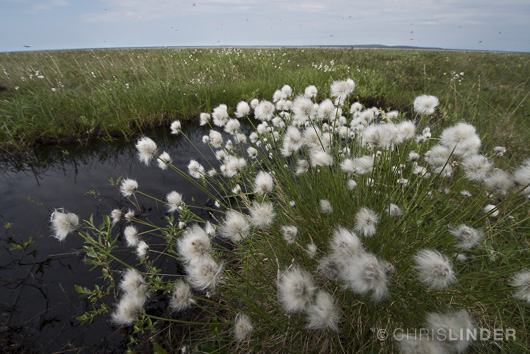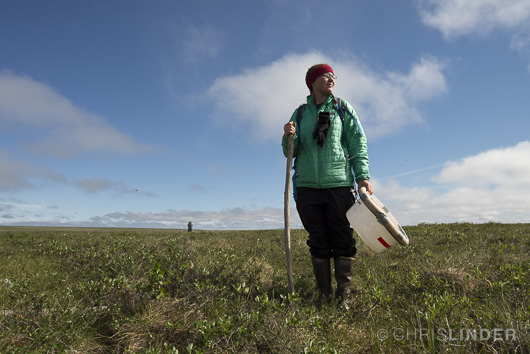Before I came to the tundra, I imagined it to be a vast, flat landscape. And it is indeed vast, but flat is the last word I would use to describe the tundra. The topography is dynamic, just on a very tiny scale. Small bumps and dips cover the entire area, making a walk less like a stroll through the park and more like a Stairmaster workout on overdrive. To add an extra challenge to the daily expeditions to my field site that is a mile and a half away from the barge, the tundra houses the walker’s worst enemy: the tussock.

The tussock.
Tussocks are a grassy looking plant, usually about a foot tall, but can be as high as three feet. The first time I saw one I was completely intrigued. They look like tiny grass huts about the width of a basketball. They have older dry brown grass strands at the bottom and newer green strands flopping out of the top. The tussock is as sturdy as a rock if you run into in from the front, but ankle-bendingly wobbly if you try to step on it from above. Julian has mastered a technique of lightly bouncing from top to top of each tussock while John Wood is able to find his footing between each plant. I have not mastered either technique. I have to mentally prepare to take on the tussock every morning before fieldwork, but they are so numerous and well hidden throughout the tundra that no matter what navigation strategy I decide to implement, the tussocks always win. After spending ten days in the tundra I never figured out how to safely pass through the tussocks without falling at least once. Each day, I lost the battle against the tussocks whenever I would take my eyes off the ground to gaze at the mountains in the distance or try to catch a glimpse of a bird taking flight from the shrubs. Thankfully, the falls are quick and the landing is soft. They are usually followed by the laughter of my field partner Jess. Fortunately, face planting into the tundra is like landing on a soft mattress. If the tussocks and the taller woody shrubs decided to team together and share common territory I would be done for. Luckily for me, they usually don’t. Truthfully, I don’t think I’ll ever figure out how to easily walk through their treacherous terrain. But, in the end, my tussock nosedives won’t stop me from exploring the beauty and diversity of the tundra. I would choose stumbling through the tundra over a stroll in the park any day.

Kenzie surveys the tussocky terrain.




Comment(1)-
Anita Hunt says
July 27, 2014 at 12:22 amFace planting is one way to see the world at another level 🙂
You mentioned that the tussock is grassy “looking”, is it, in fact, a variety of grass? It also looks like a major seed producer – what wildlife lives on the tundra that would use the tussock as a food source?
I am always asking people to describe the smells of an experience. I can see that you have sight and touch covered but what about the smells of the tundra – how would you describe it?
Wishing I was there with you!
Anita